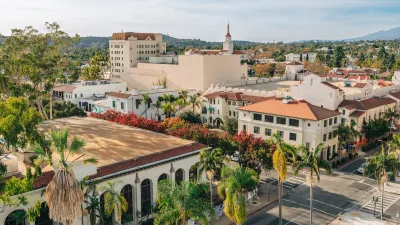That's the question some members of Santa Barbara's Architectural Board of Review are asking the coffee and donut chain as they pursue their invasion of the Golden State. Dunkin' Donuts is eyeing a Taco Bell site in the city.

Credit: Joshua Molina / Noozhawk photo
"Dunkin’ Donuts wants to move into this Taco Bell at 3771 State St. near La Cumbre Plaza, but its plan to remove the curved Taco Bell-style architecture is drawing opposition," writes Joshua Molina for Noozhawk.
Some members of the city’s Architectural Board of Review (ABR) weren’t enamored with the proposed changes. Thiep Cung said he likes the current building, which was designed by Santa Barbara architect Brian Cearnal in the 1990s. He would like some of that distinctive mission architecture to remain.
The company wants to get rid of the curved, bell-shaped architecture that adorns the front of the building, squaring it off.
It may surprise some on the East Coast, but until last year there have been no Dunkin Donuts in California. While the Canton, Mass.-based coffee and donut chain may be ubiquitous in Massachusetts, the first few have opened in California only last year in Santa Monica and Modesto, according to Jack Newsham of The Boston Globe.
Planetizen reported on a Dunkin Donuts opening in Long Beach last year that ironically involved a preservation story of its own.
Molina writes that the company plans to open 54 restaurants over the next few years.
And "California’s first-ever Dunkin’ Donuts and Baskin-Robbins drive-thru" opened on April 7 in Ramona in San Diego County, writes Monica Garske of NBC San Diego. Looking at the photo of that restaurant, one can see that straight lines are preferable to curves. The only curves appear to be the bike racks in front to the store - this is California, after all.
ABR member Cung ask the franchisee and his representative at the meeting, "can it live with a curved Dunkin’ Donuts?”
FULL STORY: Santa Barbara Dunkin’ Donuts to Open at Taco Bell Site on Upper State Street

Alabama: Trump Terminates Settlements for Black Communities Harmed By Raw Sewage
Trump deemed the landmark civil rights agreement “illegal DEI and environmental justice policy.”

Study: Maui’s Plan to Convert Vacation Rentals to Long-Term Housing Could Cause Nearly $1 Billion Economic Loss
The plan would reduce visitor accommodation by 25% resulting in 1,900 jobs lost.

Why Should We Subsidize Public Transportation?
Many public transit agencies face financial stress due to rising costs, declining fare revenue, and declining subsidies. Transit advocates must provide a strong business case for increasing public transit funding.

Paris Bike Boom Leads to Steep Drop in Air Pollution
The French city’s air quality has improved dramatically in the past 20 years, coinciding with a growth in cycling.

Why Housing Costs More to Build in California Than in Texas
Hard costs like labor and materials combined with ‘soft’ costs such as permitting make building in the San Francisco Bay Area almost three times as costly as in Texas cities.

San Diego County Sees a Rise in Urban Coyotes
San Diego County experiences a rise in urban coyotes, as sightings become prevalent throughout its urban neighbourhoods and surrounding areas.
Urban Design for Planners 1: Software Tools
This six-course series explores essential urban design concepts using open source software and equips planners with the tools they need to participate fully in the urban design process.
Planning for Universal Design
Learn the tools for implementing Universal Design in planning regulations.
Smith Gee Studio
Alamo Area Metropolitan Planning Organization
City of Santa Clarita
Institute for Housing and Urban Development Studies (IHS)
City of Grandview
Harvard GSD Executive Education
Toledo-Lucas County Plan Commissions
Salt Lake City
NYU Wagner Graduate School of Public Service





























